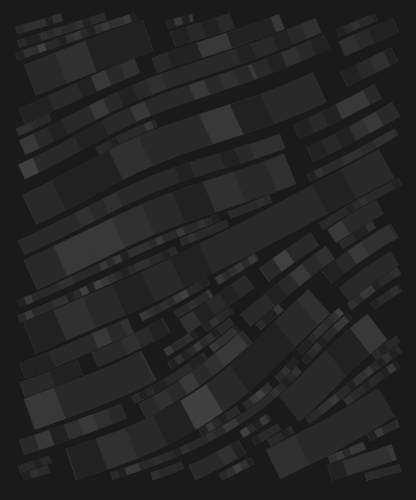
Fidenza #531 by generative artist Tyler Hobbs. At time of writing, $11,362,995.
The new NFT economy will have interesting distributive consequences within the political economy of art.
For instance, NFTs increase the income of "generative" artists (creators of programmatically generated digital images) relative to traditional, analog artists.
This might seem obvious, but I don't think it is, because the implications are significant and yet I've not seen it remarked upon.
The distributive consequences are likely to be severe, and the losers in this conflict are not going to just disappear peaceably.
The first reason that NFTs shift power to generative artists is simply because of the leverage inherent in computer programming. The first collection of NFTs to accrue extraordinary value in the most recent wave—the CryptoPunks—is a collection of 10,000 programmatically generated images. The CryptoPunks collection would have taken years for a traditional artist to complete by hand. Thus, generative artists who can generate large programmatic collections will, other things equal, outperform those who cannot. Not only will they enjoy more shots on goal to find a big break, they will learn faster thanks to far more repetitions and, of course, they will produce a greater number of total works after achieving their big break.
As power laws reign over all things digital, economic resources will pour into the war chests of the best generative artists. All but the most successful digital artists will exit the meme pool, or perhaps maintain a foothold in the new artworld by working low-paid gigs for large art DAOs.
Though I personally embrace the trend and even rejoice at its potentially world-historical significance, currently prevailing intuitions about the politics involved are quite naive. It's either unalloyed glee at a perceived democratic leveling or resentful hit pieces about energy waste.
Those who are currently getting rich from NFTs like to describe the phenomenon in warm and rosy hues. It's about community, identity, sharing, supporting each other, etc. More generally, it's becoming clear to the most astute observers that the entire crypto world is beset by systemic positivity bias.
Make no mistake, the NFT economy is an example of skill-biased technological change. Artists with computer skills will be handsomely rewarded, and artists lacking computer skills will see their stock prices fall. Unless they collaborate with programmers, which might be a promising avenue. This would mean that brokers or marketplaces connecting highly skilled traditional artists with generative programmers may also be well positioned. But old-school brokers who specialize in connecting traditional fine artists with traditional collectors are likely to meet Karen and the Boomers in the graveyard of the historically displaced.
NFTs are, in fact, quintessentially aristocratic. Extremely expensive trifles, conspicuous consumption, exclusivity that's valuable because it is possessed by those people who are valuable. The more trivial the better, as the triviality increases the costliness of the signal for the buyer. Georges Bataille called this kind of exuberant, conspicuous wastage "expenditure without reserve."
Those who "ape in" after a collection gets hot are certainly not engaging in Bataillean expenditure; they are merely hoping to trade up. The whales who spend big on what are initially worthless digital signatures may also hope to trade up, but the crucial difference is that their "expenditure without reserve" can alone make an otherwise worthless NFT valuable. Their initial purchase of a worthless JPEG is genuine Bataillean expenditure, exuberant and conspicuous wastage, but the anthropological mechanism Bataille identified is now subject to strategic exploitation after the fact.
It is not surprising that the most sophisticated theorists and artists entering the NFT space are starting to cite Bataille explicitly—for instance, Mónica Belevan's production studio The Accursed Share and their debut project, the Curse NFT, are both direct references to Bataille.
NFTs are a testament to Bataille's anthropology but also a novel type of container or pacifier of the revolutionary dynamics Bataille saw therein. Whereas the old aristocrats could not be noble and also active in vulgar commerce, the digital revolution has allowed today's aristocrats to containerize these operations and run them separately, with positive feedback loops.
If you feel behind on all of this, I would remind you we are still very, very early. There is a new aristocracy taking over, but who gets to enter this aristocracy remains up for grabs. So don't lament, and don't resent, just get moving.
Postscript for non-technical artists
If I were a visual artist, I would consider learning generative art. I did some research and I think Processing.py is the best way to start for most people. There is a nice downloadable binary that makes it pretty easy to get started, even if you've never done any programming. Then you can find code templates on the web and use them as working models to tinker with. I was able to generate non-trivial images within a few hours, just copying others and tweaking things. I think you have a better chance making an original set of NFTs and launching them on OpenSea, perhaps in cooperation with a public writer or creator—ahem—than doing so with your analogue art, for reasons mentioned above. And as far as speculating goes, it's now pretty hard to buy into a hot collection, because every hot collection quickly becomes unaffordable for most people. By investing in computerized workflows, even if you don't succeed at first, at least you're retooling with skills that will serve you well as the digital revolution continues.